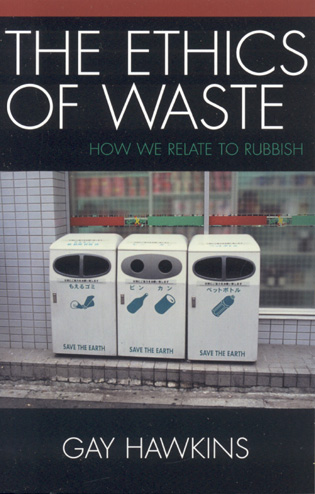Gay Hawkins: The ethics of waste. How we relate to rubbish (2006)
Exploring a recently published Norwegian picturebook composed of various sorts of material out of place – like waste, fabric fragments, and parts of discarded object – carefully reorganized, assembled, and stitched and glued together, I became aware of Gay Hawkins’ seminal (in my opinion), and at that time (2006), timely and refreshing book on waste contending that “[w]aste is much more than what we want to get rid of” (p. vii).
Hawkins claims that the aim of The ethics of waste is to focus on “the ways waste is implicated in the making of a self and particular ethical sensibilities” (p. ix). Since the apparent focus of the picturebook was to discuss and challenge views on mess, waste, chaos, classifying, order, and inclusion/exclusion, I found that Hawkins’ statement that waste “isn’t a fixed category of things; it is an effect of classification and relations” resonated with what seemed to be at stake in the book. Hence, although Hawkins’ book was published in 2006, it is still worth visiting and include in eco-oriented dialogues about how consumption, use, reuse, recycling, source separation, and care are depicted in literature but also aesthetically materialized in the literary product.
.
The ethics of waste consists, in addition to the introduction, of six chapters each composed of a self-reflective and theoretical introductory part followed by a more analytical part, discussing specific examples from film, art and literature. Already in the first chapter Hawkins makes it clear to the reader that she will avoid moralism and fueling guilt conscience. In her opinion such approaches run the risk of creating loath and anger in people.
Instead, she likes to encourage the reader – us – “to think about the complexity of our relations with the material world that wasted things carry as traces on their scratched and broken surfaces (and) to investigate the ways in which objects become waste, the practices of valuing and classification that render them useless” (p. 13). According to Hawkins what unites her analyses “is a desire to think about how unexpected experiences of waste can disrupt habits and trigger new relations and perceptions” (p. 16). And this is what made me curious about her book and eager to bring her thoughts into dialogue with the picturebook in order to imagine possible ways for young readers to enter the field of environmental ethics and politics. One such eye-opening inquiry suggested by Hawkins is: «Could it possibly be more ‘environmentally friendly’ to feel sympathy and ethical concern for rubbish rather than disgust and anxiety about its destructive impact on nature?» (p. 23).
I find this question fundamental and applicable to various educational or formative activities (intra)connected with literary matters. I like to work with young readers, primary school teachers, student teachers, literature, and waste in similar ways to those that Hawkins found in the literary and film examples she explored where waste, according to Hawkins, «as dead objects throws up few possibilities, but waste as things is full of promise, full of the possibilities of becoming a resource for being” (s. 75). And I like to follow Hawkins’ call for changing attitudes through affection and “collaborative generosity” (p. 124) instead of forced by guilt or alienation. Reading The ethics of waste. How we relate to rubbish encourages me to think and engage differently with books, waste, and educational practices, first of all because of its insistence on changing attitudes through tactile closeness and critical responsiveness when faced with waste -which is every day and everywhere.
21.12.2023 by Nina Goga, Høgskulen på Vestlandet
The Norwegian picturebook mentioned here is Sinko og Flinko stablar om (2022) by Helga Gunerius Eriksen
